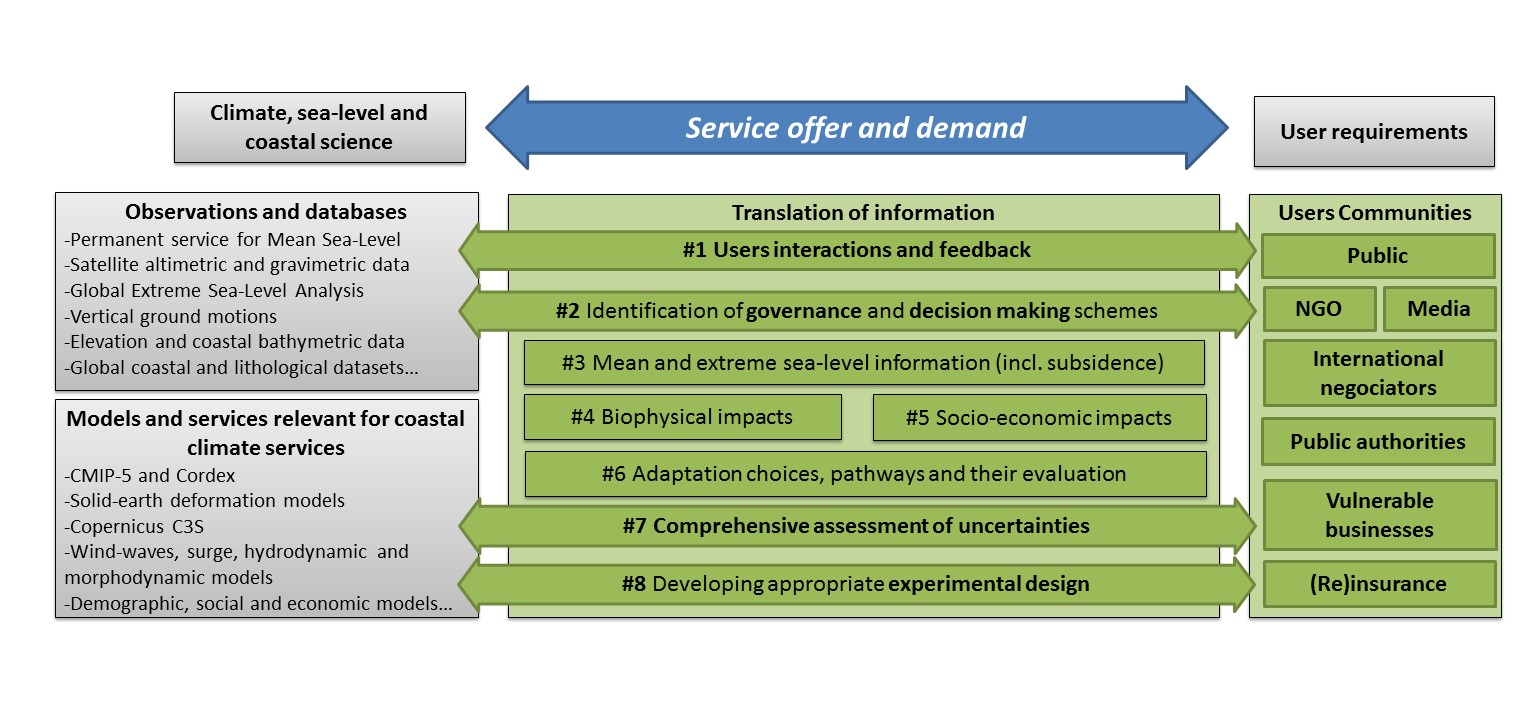Sea Level Change and Coastal Climate Services: The Way Forward

Figure 1 (as reproduced from Figure 6 of Le Cozannet et al., 2017): A framework for developing Coastal Climate Services. The middle boxes show areas where research and developments are needed to support the development and operationalization of coastal climate services (After: Monfray and Bley, 2016).
For many climate change impacts such as drought and heat waves, global and national frameworks for climate services are providing ever more critical support to adaptation activities (Hewitt et al., 2012; Brasseur and Gallardo, 2016; Monfray and Bley, 2016). Coastal zones are especially in need of climate services for adaptation, as they are increasingly threatened by sea level rise and its impacts, such as submergence, flooding, shoreline erosion, salinization and wetland change (e.g., Wong et al., 2014; Sweet and Park, 2014). An important component of these services will be sea level scenarios and projections aligned to the needs of users (Nicholls et al., 2014; Hinkel et al., 2015; McInnes et al., 2015).
Coastal scientists involved in the “Regional sea level changes and coastal impacts” Grand Challenge of the World Climate Research Programme (WCRP) have reviewed how annual to multi-decadal sea level projections can be used within coastal climate services. The resulting review article (Le Cozannet et al., 2017) examines the current state-of-the art of coastal climate services in the US, Australia and France, and identifies lessons learned. More broadly, the article also reviews current barriers in the development of coastal climate services, and identifies research and development efforts for overcoming barriers and facilitating their continued growth (Figure 1). The latter includes:
- research in the field of sea level, coastal and adaptation science, in order to: (a) increase confidence in coastal impact models (e.g., shoreline changes); (b) respond to user’s needs for sea level information (sea level projections considering near-term (seasonal to decadal) and long term (beyond 2100) timescales, local to regional vertical ground motions); and (c) describe (and reduce) the related uncertainties.
- cross-cutting research in the area of user interactions, decision making, propagation of uncertainties and overall service architecture design
As a conclusion, this work suggests that standard approaches are required to translate relative sea level information into the forms required to support the wide range of relevant decisions across coastal management, including coastal adaptation.
Summary written by Gonéri Le Cozannet.
Other references:
Brasseur, G.P.; Gallardo, L. Climate services: Lessons learned and future prospects. Earths Future 2016, 4, 79–89.
Hewitt, C.; Mason, S.; Walland, D. Commentary: The global framework for climate services. Nat. Clim. Chang. 2012, 2, 831–832.
Hinkel, J.; Jaeger, C.; Nicholls, R.J.; Lowe, J.; Renn, O.; Shi, P.J. Sea-level rise scenarios and coastal risk management. Nat. Clim. Chang. 2015, 5, 188–190.
McInnes, K.L.; Church, J.A.; Monselesan, D.; Hunter, J.R.; O’Grady, J.G.; Haigh, I.D.; Zhang, X. Sea-level Rise Projections for Australia: Information for Impact and Adaptation Planning. Aust. Meteorol. Oceanogr. J. 2015, 65, 127–149.
Monfray, P.; Bley, D. JPI Climate: A key player in advancing Climate Services in Europe. Clim. Serv. 2016, 4, 61–64.
Nicholls, R.J.; Hanson, S.E.; Lowe, J.A.; Warrick, R.A.; Lu, X.F.; Long, A.J. Sea-level scenarios for evaluating coastal impacts. Wiley Interdiscip. Rev.-Clim. Chang. 2014, 5, 129–150.
Sweet, W.V.; Park, J. From the extreme to the mean: Acceleration and tipping points of coastal inundation from sea level rise. Earths Future 2014, 2, 579–600.
Wong, P.P.; Losada, I.J.; Gattuso, J.-P.; Hinkel, J.; Khattabi, A.; McInnes, K.L.; Saito, Y.; Sallenger, A. Coastal systems and low-lying areas. In Climate Change 2014: Impacts, Adaptation, and Vulnerability; Part A: Global and Sectoral Aspects. Contribution of Working Group II to the Fifth Assessment Report of the Intergovernmental Panel on Climate Change; Field, B.C., Barros, V.R., Dokken, D.J., Mach, K.J., Mastrandrea, M.D., Bilir, T.E., Chatterjee, M., Ebi, K.L., Estrada, Y.O., Genova, R.C., et al., Eds.; Cambridge University Press: Cambridge, UK; New York, NY, USA, 2014; pp. 361–409.













